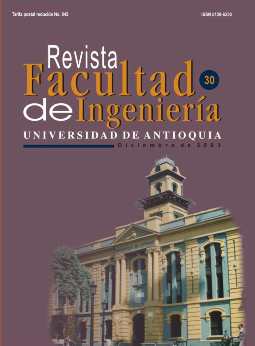Biosorción de Fe, Al y Mn de drenajes ácidos de mina de carbón empleando algas marinas sargassum sp. en procesos continuos
DOI:
https://doi.org/10.17533/udea.redin.327309Palabras clave:
Drenajes ácidos de mina (DAM), remoción de metales, Fe, Mn, Al, algas pardas, sargassum sp., procesos de biosorción en continuoResumen
Los drenajes ácidos de mina (DAM) son lixiviados resultantes de la explotación minera de carbón, presentan bajos pH y altas concentraciones de metales pesados que los convierten en fuertes contaminantes. Con el fin de disminuir su concentración, se diseñó un sistema de biosorción en continuo para remover los metales pesados de los drenajes empleando un material biosorbente económico, como las algas. Se estudió el efecto que tiene pretratar el alga sargassum sp. antes del proceso de biosorción, con soluciones 0,1 N de NaOH, Ca(OH)2, NaCl, CaCl2, Na2SO4 y H2SO4; se obtuvieron porcentajes de remoción superiores al 80% a excepción del pretratamiento con H2SO4, el cual anuló la capacidad de sorción del alga. Se analizó la influencia de empaquetar el alga en dos materiales (malla plástica y tul poliéster) con una configuración de prisma rectangular; pero se encontró que el material de empaquetamiento no afecta el proceso de biosorción de metales. Se estudió el proceso de biosorción en continuo en dos unidades de operación: una columna de lecho fijo con flujo ascendente y un tanque horizontal seccionado tipo canaleta con bafles, los cuales trataron adecuadamente 3,5 y 4,7 l de DAM respectivamente, empleando en cada uno de ellos 100 g de alga. Para solucionar el problema del alga residual, se optó por estudiar su calcinación como alternativa para su manejo. La ceniza obtenida a 700 ºC mantiene los metales removidos del DAM, además permanece estable al ataque de soluciones de diferente pH.
Descargas
Citas
Murcia, Emma y Claudia Trillos. Estudio cinético para la predicción de la formación de drenajes ácidos en minas de carbón. Universidad Industrial de Santander. Escuela de Ingeniería Química. Bucaramanga, 2000. pp. 5-20.
Duarte, Leusmary y Raquel Villafrades. Remoción de Fe y Mn provenientes de drenajes ácidos de minas de carbón utilizando algas y plantas acuáticas. Universidad Industrial de Santander. Escuela de Ingeniería Química. Bucaramanga, 2001. pp. 74-76.
Laverde, Dionisio et al. Prevención por drenajes ácidos de minas de carbón. Informe final presentado a Colciencias-Minercol. Bucaramanga, 2001. pp. 18-28.
Hedin, R. S. et al. Passive treatment of coal mine drainaje. United States Departament of interior. Bureau of Mines. 1993.
Clayton, L. y T. Wildeman. Processes contributing to the removalremoval of manganese from mine drainage by an algal mixture. National Meeting of the American Society for Surface Mining and Reclamation. Saint Louis, Missouri. Mayo, 1998. pp. 17-22. DOI: https://doi.org/10.21000/JASMR98010192
Volesky, Bohumil. Biosorption of heavy metals. Editorial CRC Press. Boca Raton, 1990. pp. 173-194.
Falbo, M. B. y T. A. Weaks. “Comparison of eichornia crassipes (pontederiaceae) and sphagnnum quinquefarium (sphagnadaceae) in treatment of acid mine water”. En: Economic-Botany. Vol. 44. No. 1. 1990. pp. 40-49. DOI: https://doi.org/10.1007/BF02861065
Hargreaves, Robert et al. Removing heavy metals from liquid effluents using biomasses. Workshop. CANMET/CETEM. Rio de Janeiro, 1997. pp. 1-12.
Kratochvil, David y Bohumil Volesky. “Biosorption of Cu from ferruginous wastewater by algal biomass”. En: Wat. Res. Vol. 32. No. 9. Gran Bretaña, 1998. pp. 2.760-2.768. DOI: https://doi.org/10.1016/S0043-1354(98)00015-3
Volesky, B. e I. Prasetyo. “Cadmium removal a biosorption column”. En: Biotechnology and Bioengineering, Vol. 43. John Wiley & Sons Inc. 1994. pp. 1.010-1.015. DOI: https://doi.org/10.1002/bit.260431103
Adam, K. et al. “A review of passive systems for the treatment of acid mine drainage”. En: Mineral Engineering. Vol. 9. No. 1. pp. 23-42. DOI: https://doi.org/10.1016/0892-6875(95)00129-8
Da Costa, Antonio et al. Batch and continuous heavy metals biosorption by a brown seaweed. Tecnología Ambiental, Serie 12. MCT, CETEM, CNPQ. Rio de Janeiro, 1996.
Orozco, A. Control de contaminación del agua en la pequeña minería subterránea del carbón. Informe final presentado a Ecocarbón. Bogotá, Agosto de 1995.
García, Sandra e Higuera, Óscar. Reducción del cromo contenido en efluentes líquidos de la industria del cuero, mediante un proceso adsorción-desorción con algas marinas. Universidad Industrial de Santander. Escuela de Ingeniería Metalúrgica. Bucaramanga, 2000. pp. 68-69.
Gusek, J. J. Passive treatment of acid rock drainage What is the potential bottom line? Minino Engineering. Marzo, 1995. pp. 250-253.
Descargas
Publicado
Cómo citar
Número
Sección
Licencia
Los artículos disponibles en la Revista Facultad de Ingeniería, Universidad de Antioquia están bajo la licencia Creative Commons Attribution BY-NC-SA 4.0.
Eres libre de:
Compartir — copiar y redistribuir el material en cualquier medio o formato
Adaptar : remezclar, transformar y construir sobre el material.
Bajo los siguientes términos:
Reconocimiento : debe otorgar el crédito correspondiente , proporcionar un enlace a la licencia e indicar si se realizaron cambios . Puede hacerlo de cualquier manera razonable, pero no de ninguna manera que sugiera que el licenciante lo respalda a usted o su uso.
No comercial : no puede utilizar el material con fines comerciales .
Compartir igual : si remezcla, transforma o construye a partir del material, debe distribuir sus contribuciones bajo la misma licencia que el original.
El material publicado por la revista puede ser distribuido, copiado y exhibido por terceros si se dan los respectivos créditos a la revista, sin ningún costo. No se puede obtener ningún beneficio comercial y las obras derivadas tienen que estar bajo los mismos términos de licencia que el trabajo original.










 Twitter
Twitter